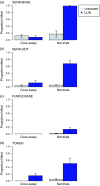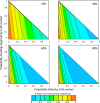Empirical and theoretical investigation into the potential impacts of insecticide resistance on the effectiveness of insecticide-treated bed nets
- PMID: 29636797
- PMCID: PMC5891045
- DOI: 10.1111/eva.12574
Empirical and theoretical investigation into the potential impacts of insecticide resistance on the effectiveness of insecticide-treated bed nets
Abstract
In spite of widespread insecticide resistance in vector mosquitoes throughout Africa, there is limited evidence that long-lasting insecticidal bed nets (LLINs) are failing to protect against malaria. Here, we showed that LLIN contact in the course of host-seeking resulted in higher mortality of resistant Anopheles spp. mosquitoes than predicted from standard laboratory exposures with the same net. We also found that sublethal contact with an LLIN caused a reduction in blood feeding and subsequent host-seeking success in multiple lines of resistant mosquitoes from the laboratory and the field. Using a transmission model, we showed that when these LLIN-related lethal and sublethal effects were accrued over mosquito lifetimes, they greatly reduced the impact of resistance on malaria transmission potential under conditions of high net coverage. If coverage falls, the epidemiological impact is far more pronounced. Similarly, if the intensity of resistance intensifies, the loss of malaria control increases nonlinearly. Our findings help explain why insecticide resistance has not yet led to wide-scale failure of LLINs, but reinforce the call for alternative control tools and informed resistance management strategies.
Keywords: Anopheles; insecticide resistance; malaria; transmission.
Figures







References
-
- Allossogbe, M. , Gnanguenon, V. , Yovogan, B. , Akinro, B. , Anagonou, R. , Agossa, F. , … Akogbeto, M. (2017). WHO cone bio‐assays of classical and new‐generation long‐lasting insecticidal nets call for innovative insecticides targeting the knock‐down resistance mechanism in Benin. Malaria Journal, 16, 77 https://doi.org/10.1186/s12936-017-1727-x - DOI - PMC - PubMed
-
- Alout, H. , Djègbè, I. , Chandre, F. , Djogbénou, L. S. , Dabiré, R. K. , Corbel, V. , & Cohuet, A. (2014). Insecticide exposure impacts vector–parasite interactions in insecticide‐resistant malaria vectors. Proceedings of the Royal Society B, 281, 20140389 https://doi.org/10.1098/rspb.2014.0389 - DOI - PMC - PubMed
-
- Alout, H. , Yameogo, B. , Djogbénou, L. S. , Chandre, F. , Dabiré, R. K. , Corbel, V. , & Cohuet, A. (2014). Interplay between Plasmodium infection and resistance to insecticides in vector mosquitoes. Journal of Infectious Diseases, 210, 1464–1470. https://doi.org/10.1093/infdis/jiu276 - DOI - PubMed
-
- Amenya, D. A. , Naguran, R. , Lo, T.‐C. M. , Ranson, H. , Spillings, B. L. , Wood, O. R. , … Koekemoer, L. L. (2008). Over expression of a cytochrome P450 (CYP6P9) in a major African malaria vector, Anopheles funestus, resistant to pyrethroids. Insect Molecular Biology, 17, 19–25. http://10.1111/j.1365-2583.2008.00776.x - DOI - PubMed
-
- Bagi, J. , Grisales, N. , Corkill, R. , Morgan, J. C. , N'Falé, S. , Brogdon, W. G. , & Ranson, H. (2015). When a discriminating dose assay is not enough: Measuring the intensity of insecticide resistance in malaria vectors. Malaria Journal, 14, 210 https://doi.org/10.1186/s12936-015-0721-4 - DOI - PMC - PubMed
Associated data
Grants and funding
LinkOut - more resources
Full Text Sources
Other Literature Sources
Miscellaneous

